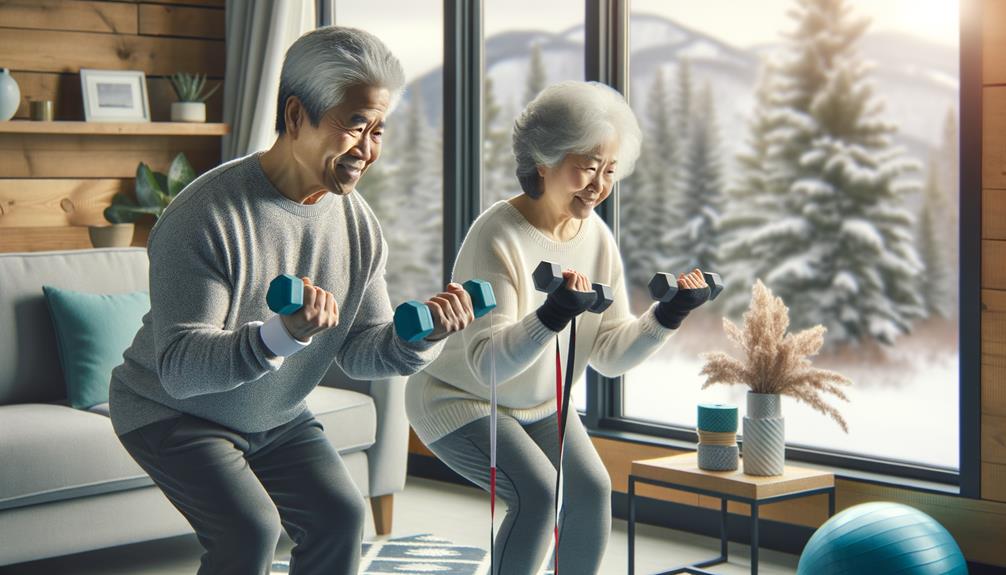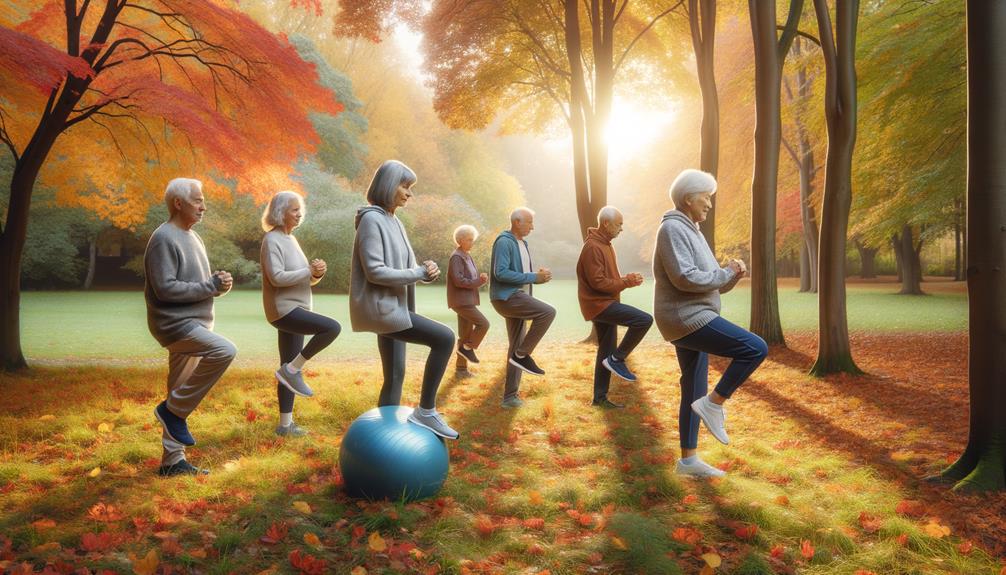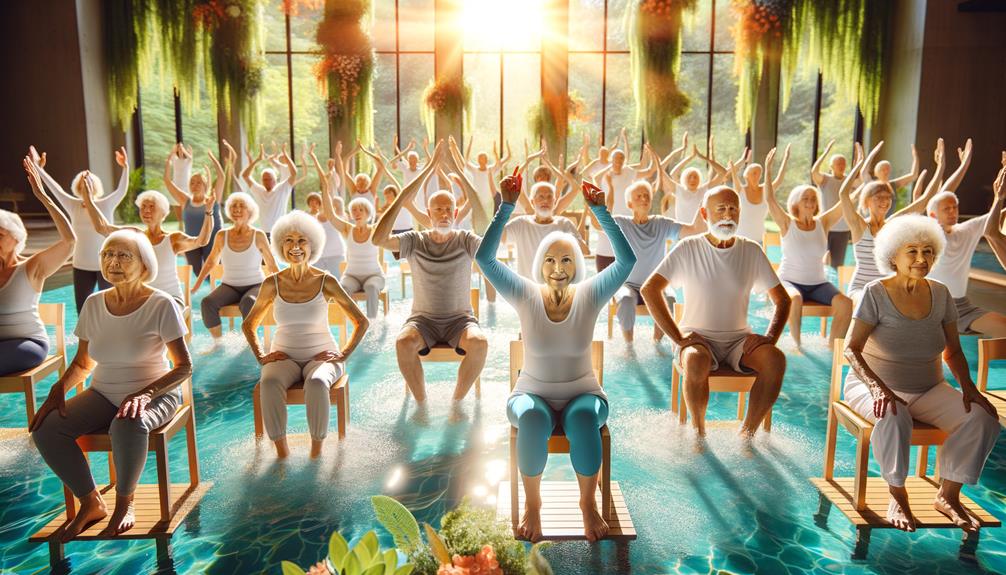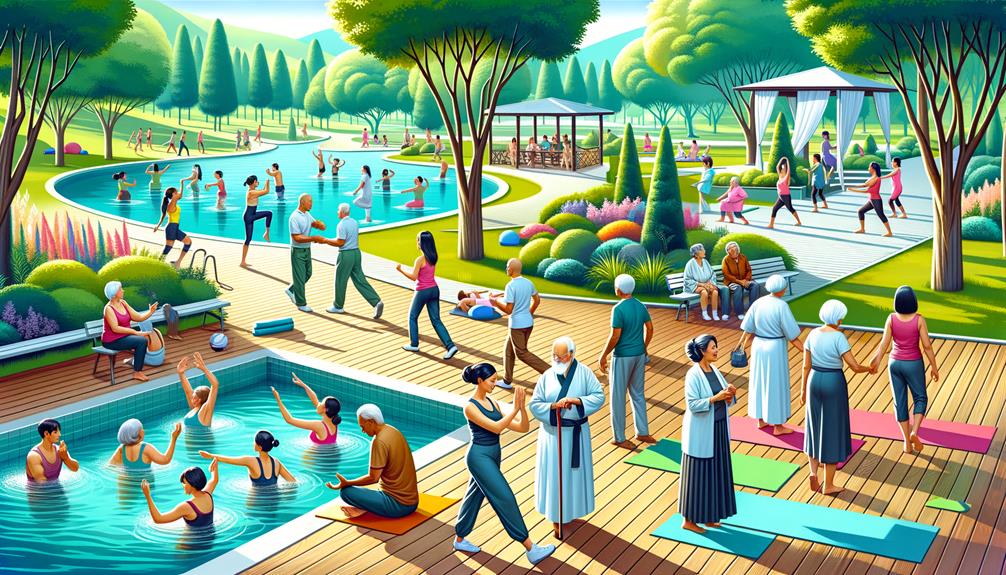Staying active is crucial for Canadian seniors, and low-impact exercises are a great way to maintain our health. Short walks can improve heart health and boost our cardiovascular fitness. Strengthening exercises, like light weightlifting or bodyweight exercises, help keep our muscles strong and maintain bone density. Gentle stretches can enhance our flexibility and reduce the risk of injury. Balance exercises, such as dancing or water aerobics, can improve our stability and prevent falls. Participating in group activities, like chair aerobics, offers social benefits and motivation. Setting realistic goals and mixing up our routines can help us stay consistent. By incorporating these exercises into our daily lives, we can improve our overall well-being.
Benefits of Low-Impact Exercises
Low-impact exercises offer numerous benefits for seniors, including reducing stress on joints, improving cardiovascular health, and enhancing muscle strength and flexibility. By engaging in activities like walking, swimming, yoga, and cycling, seniors can stay active without risking injury or exacerbating existing conditions. These exercises are especially beneficial for those with mobility issues or chronic pain, as they minimize the strain on joints and muscles.
Research shows that low-impact exercises can significantly lower the risk of heart disease in seniors. Regular participation in these activities can improve circulation, lower blood pressure, and enhance overall heart function. Additionally, improved muscle strength and flexibility from low-impact exercises contribute to better balance and coordination, which can help prevent falls—a common concern among the elderly.
Before starting any new exercise regimen, seniors should consult with a healthcare provider to ensure the chosen activities are safe and suitable for their individual health conditions. As caregivers or health professionals, encouraging and supporting seniors in adopting low-impact exercises can lead to improved physical and mental well-being, ultimately enhancing their quality of life. By prioritizing these exercises, we can help our senior community thrive.
Walking Intervals for Heart Health

Walking intervals offer a great way for seniors to boost their heart health by increasing their heart rate and improving cardiovascular fitness. This exercise involves alternating between periods of brisk walking and slower-paced walking, allowing seniors to manage their heart rate effectively. By incorporating walking intervals into their routine, seniors can promote better cardiovascular health without putting excessive strain on their joints.
Adding arm movements during walking intervals enhances the workout further by engaging upper body muscles. This not only improves overall fitness but also enhances coordination. Maintaining consistent arm and leg movements throughout the session is crucial for maximizing these benefits.
Pacing is critical, so it's essential to manage your pace during walking intervals. You should aim for a pace that raises your heart rate but remains comfortable enough to sustain. Completing about 900-1000 steps in a walking interval class can help you reach a beneficial level of physical activity, promoting better heart health over time.
Incorporating walking intervals into your exercise routine provides a simple yet effective way to improve cardiovascular fitness while being mindful of your body's capabilities. By doing so, you can enjoy a healthier heart and a more active lifestyle.
Strengthening Exercises for Seniors

Strengthening exercises are crucial for seniors to maintain muscle mass, enhance bone density, and improve overall strength, which supports daily activities and reduces the risk of falls. With simple equipment like resistance bands, hand weights, or even household items like water bottles, we can target different muscle groups effectively. Many fitness centers in Canada offer machines specifically designed for seniors, ensuring safety and effectiveness.
Regular exercise helps prevent falls, improves posture, and enhances mobility. It's essential to seek guidance from fitness instructors or physical therapists to ensure proper form and technique, maximizing benefits while minimizing the risk of injury.
Some simple strengthening exercises to incorporate into our routine include:
| Exercise | Equipment |
|---|---|
| Seated Leg Lifts | None |
| Bicep Curls | Hand Weights |
| Wall Push-Ups | None |
| Resistance Band Rows | Resistance Bands |
Incorporating these low-impact exercises into our daily routine can significantly improve our quality of life. It's essential to start slowly and gradually increase the intensity to suit our fitness levels. By prioritizing these exercises, we can stay active, independent, and healthy for years to come.
Improving Flexibility With Gentle Stretches

Incorporating gentle stretches into our daily routine can greatly enhance flexibility, reduce the risk of injuries, and improve overall movement function in seniors. For older adults, daily stretching for at least 10 minutes can greatly boost joint mobility, posture, and overall movement function. By increasing our range of motion, we not only enhance our physical capabilities but also minimize the risk of injury during everyday activities.
To get the most out of stretching, it's essential to warm up first. This preparation gets our muscles and joints ready, promoting better performance and preventing strains. Simple yet effective stretches for seniors include shoulder rolls, neck stretches, and calf stretches. These exercises are particularly beneficial in alleviating stiffness and promoting relaxation.
Regular stretching offers more than just physical benefits; it can also contribute to maintaining our independence. Enhanced flexibility helps in achieving better balance and stability, which are important for older adults. By incorporating these simple stretches into our daily regimen, we can look forward to a more agile, injury-free lifestyle.
Balance Exercises to Prevent Falls

Focusing on balance exercises is crucial for preventing falls among seniors. Strengthening our core muscles and improving our coordination and posture can greatly reduce the risk of injury. By incorporating these exercises into our daily routine, we can maintain our independence and enjoy a better quality of life.
Strengthening Core Muscles
Engaging in balance exercises, such as standing on one leg or heel-to-toe walking, can greatly enhance core strength and reduce the risk of falls in seniors. These activities are crucial for improving stability and preventing falls and related injuries. By incorporating simple balance exercises into our daily routine, we can significantly strengthen our core muscles, which play a vital role in maintaining good posture and supporting our spine.
Let's focus on practical exercises. Standing on one leg is a straightforward way to challenge our balance. Start by holding onto a sturdy chair or countertop, and gradually try to balance on one leg for 10-15 seconds at a time. Heel-to-toe walking, where we place the heel of one foot directly in front of the toes of the other, is another effective exercise. This can be done along a hallway or any straight path.
Regularly practicing these balance exercises not only strengthens our core but also enhances our overall mobility. This increased stability helps us maintain independence and boosts our confidence in performing daily activities. By making these exercises a regular part of our routine, we can significantly improve our quality of life.
Enhancing Coordination Skills
Building on core-strengthening exercises, let's focus on enhancing coordination skills through balance exercises to prevent falls. By incorporating these exercises into our daily routine, we can greatly improve our stability and mobility, which are vital for maintaining independence and confidence in our movements.
Exercises like dancing and water aerobics can be highly effective. Even dedicating just 10 minutes a day can make a noticeable impact. For those with limited mobility, chair aerobics classes offer an accessible way to enhance cardiovascular health and balance.
Regular balance exercises not only reduce the risk of falling but also promote confidence in our daily activities. This is particularly important for seniors who wish to maintain their physical well-being and enjoy an active lifestyle.
Here's a quick reference table to summarize some beneficial balance exercises:
| Exercise Type | Duration | Benefits |
|---|---|---|
| Dancing | 10 minutes | Improves coordination, mobility |
| Water Aerobics | 10 minutes | Enhances balance, low impact |
| Chair Aerobics | 15 minutes | Boosts cardiovascular health |
| Single-leg Stands | 5 minutes | Strengthens leg muscles, balance |
| Heel-to-Toe Walking | 5 minutes | Enhances stability, coordination |
Improving Posture Stability
Improving posture stability is crucial for preventing falls and maintaining overall well-being. Engaging in activities like dancing, water aerobics, and chair aerobics can greatly enhance our balance and coordination. These exercises reduce the risk of falling and promote better physical health.
Dedicating just 10 minutes a day to balance exercises can make a significant difference in our mobility and reduce the likelihood of accidents. For example, participating in chair aerobics classes can improve our cardiovascular health while also enhancing our balance and stability. This dual benefit ensures we stay active and safeguard ourselves against potential falls.
Incorporating these exercises into our daily routine can lead to a marked improvement in our overall physical health and well-being. Prioritizing balance exercises reduces the risk of falls, a significant concern for seniors. By doing so, we enhance our quality of life and maintain our independence. By committing to these simple yet effective exercises, we can improve our posture stability and safeguard our safety.
Fun Group Exercise Ideas

Group exercise classes like chair aerobics, dancing, and water aerobics offer Canadian seniors a fun and effective way to stay active and healthy. These activities not only improve cardiovascular health but also enhance balance, strength, and flexibility. By incorporating these exercises into their routine, seniors can reap numerous benefits.
Water aerobics, for instance, provides a low-impact workout that's gentle on the joints while building muscle strength. This makes it an excellent option for seniors who want to maintain their fitness levels without straining their bodies.
Chair aerobics classes are particularly suitable for those with mobility issues. These classes allow participants to engage in a safe and effective exercise routine, often involving rhythmic movements that boost cardiovascular health without requiring excessive standing or movement.
Group exercise classes also provide a supportive and motivating environment, which can enhance social connections and overall well-being. Here are three fun group exercise ideas worth exploring:
- Chair Aerobics – Ideal for seniors with mobility issues.
- Water Aerobics – Low-impact yet effective for muscle strengthening.
- Dancing – Fun and great for cardiovascular health.
Staying active together makes fitness enjoyable and sustainable for Canadian seniors.
Tips for Staying Consistent

To maintain consistency with our low-impact exercises, set specific and achievable goals, and establish a regular routine. Exercising with a buddy or joining a group class can provide motivation and a sense of responsibility. Remember to vary your activities to keep things interesting and track your progress to celebrate small victories.
Set Realistic Goals
Setting realistic goals is crucial for maintaining consistency in our fitness routines. As seniors, regular physical activity can greatly benefit our overall health, as highlighted by Kathryn Rateliff. To stay motivated and consistent, it's essential to break down our fitness goals into manageable steps.
Three practical tips for setting realistic goals include:
- Be Specific: Instead of vague objectives, aim for clear targets, such as walking 30 minutes a day or attending a yoga class twice a week. This specificity makes it easier to track and achieve our goals.
- Monitor Progress: Keeping a fitness journal allows us to monitor our progress and celebrate small achievements. Documenting our journey provides a sense of accomplishment and helps identify areas needing improvement.
- Get Support: Finding a workout buddy or joining a senior fitness group can provide the accountability and encouragement we need. Social interactions make physical activity more enjoyable and less of a chore.
Create a Routine
Establishing a consistent exercise routine is crucial for seniors to maintain and improve their overall health. Scheduling workouts on specific days of the week, such as Mondays, Wednesdays, and Fridays, helps build a habit and allows for adequate rest between sessions.
To track progress, it's helpful to keep a workout journal. Recording exercises, duration, and intensity not only monitors improvements but also motivates us to continue. Seeing endurance and strength increase over time is rewarding.
Varying exercises prevents boredom and keeps us engaged. A mix of activities like walking, swimming, and yoga targets different muscle groups, contributing to a well-rounded fitness regimen.
Acknowledging small achievements is vital. Whether we achieve a new personal best or stick to our schedule for a month, recognizing these milestones encourages continued commitment to our exercise routine.
Find Exercise Buddies
Finding exercise buddies can greatly boost our motivation and accountability, making it easier to stick to a low-impact exercise routine. By teaming up with others, we can turn our workouts into enjoyable social activities that we look forward to. Here are some practical steps to find exercise buddies and maintain consistency:
- Community Centers and Senior Centers: Local community centers and senior centers often offer group exercise classes and social events designed specifically for seniors. Joining these can help us meet like-minded individuals who are also committed to staying active.
- Local Fitness Classes: Many fitness studios and gyms offer low-impact exercise classes customized for seniors. These classes not only provide a structured workout but also create opportunities to connect with potential exercise buddies.
- Online Platforms: Websites and apps dedicated to fitness and social connections can help us find exercise partners. Platforms like Meetup or specific senior fitness forums can be instrumental in building a supportive exercise network.
Sharing our fitness goals, celebrating progress, and addressing challenges together fosters a supportive environment. Whether through walking groups or fitness classes, being part of a community encourages us to stay active consistently. Let's take advantage of these opportunities to find our exercise buddies and achieve our low-impact exercise goals together.
Frequently Asked Questions
What Are the Exercise Recommendations for Seniors in Canada?
Canadian seniors should aim for 150 minutes of moderate-intensity aerobic exercise weekly, supplemented with strength training exercises twice a week. Additionally, incorporating flexibility and balance exercises into their routine can help improve range of motion and prevent falls.
What Are the Four Main Types of Exercise That Seniors Need to Stay Healthy?
The four main types of exercise seniors need to stay healthy are endurance, strengthening, flexibility, and balance exercises. By incorporating activities like walking, weightlifting, yoga, and chair aerobics into their routine, seniors can maintain their physical fitness and reduce the risk of falls and injuries.
What Is the Number One Balance Exercise for Seniors?
The most effective balance exercise for seniors is surprisingly simple: Tai Chi. Studies have consistently shown that Tai Chi improves balance, flexibility, and strength, making it an excellent way to enhance stability and overall well-being.
Why Is Low-Impact Exercise Good for Older Adults?
Low-impact exercise is particularly beneficial for older adults as it's gentle on joints, reducing the risk of injury while improving cardiovascular health, strength, flexibility, and balance. This type of exercise helps maintain independence, manage arthritis, and enhance mental well-being.



